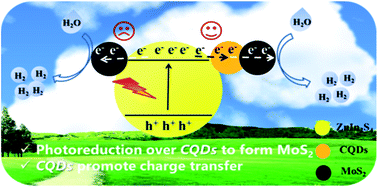MoS2/CQDs obtained by photoreduction for assembly of a ternary MoS2/CQDs/ZnIn2S4 nanocomposite for efficient photocatalytic hydrogen evolution under visible light†‡
Abstract
MoS2/CQDs (CQDs stands for carbon quantum dots) with a mass ratio of MoS2/CQDs of 1 : 5 were obtained via photoreduction of (NH4)2MoS4 over irradiated CQDs in the presence of methanol as a sacrificial agent. Self-assembly of ZnIn2S4 microspheres on the surface of MoS2/CQDs was realized under microwave conditions to obtain ternary MoS2/CQDs/ZnIn2S4 microspheres. The ternary MoS2/CQDs/ZnIn2S4 nanocomposite shows significantly superior photocatalytic activity for hydrogen evolution to both MoS2/ZnIn2S4 and CQDs/ZnIn2S4, indicating the existence of a synergistic effect of MoS2 and CQDs in promoting the hydrogen evolution. It was proposed that the transfer of the photo-generated electrons from the semiconductor-based photocatalyst (ZnIn2S4) to the hydrogen evolution cocatalyst (MoS2) is promoted by CQDs acting as a mediator in the ternary MoS2/CQDs/ZnIn2S4 nanocomposite. An optimum performance was observed over a 3.0 wt% MoS2/CQDs/ZnIn2S4 nanocomposite in the presence of Na2S/Na2SO3 as a sacrificial agent, where 750 μmol of hydrogen was evolved in 5 h. The optimum apparent quantum efficiency (AQE) was determined to be 25.6% at a wavelength of 420 nm, which is among the highest AQEs ever reported for ZnIn2S4-based systems. This study provides a strategy for developing highly efficient photocatalysts for hydrogen evolution via using CQDs as a bridge to promote charge transfer in nanocomposites.



 Please wait while we load your content...
Please wait while we load your content...